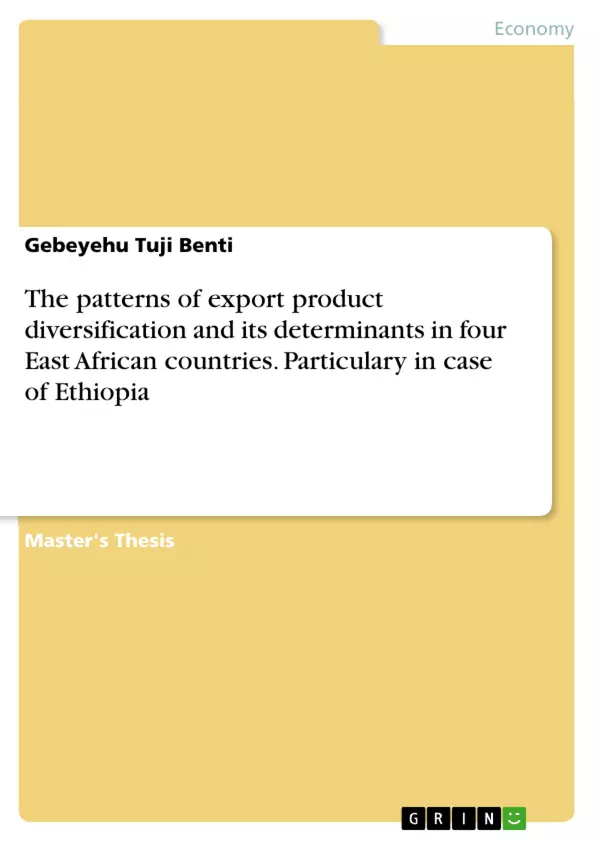This paper assesses the patterns of export product diversification and identifies its determinants in four east African countries particularly focus on the case of Ethiopia. In addition to this, the study develops lessons from East Asian countries as best experience to know the way they have followed to achieve export product diversification with less than three decades. The research conducts Herfindahl-Hirschman index to see the degree of export product diversification, balanced panel data to examine determinants of export product diversification using GLS random effect model and descriptive statistics for the year 1995-2014.
The statistical data collected from WDI, UNCTAD, ERCA, NBE and ADI data bases. The study also conducts Huasman specification test to select the best model for the study and Breusch-Peagan test to check the existence of heteroscedasticity and used one year lag-values in log form to detect the endogeneity problems and some of the variables like labor force and saving effect may not observed immediately on diversification. According to the finding, the HHI for east African countries export product diversification shows as they concentrated on few products. However it shows an improvements from year to year with gradual changes. In 1995-2014 Ethiopia, Rwanda and Ugandan export highly concentrated but since 2001 Ethiopia and Uganda export performance shows moderately improved compare to the previous years.
The regression result of the study suggests that exchange rate, gross domestic saving, inflation, PGDP, openness to trade, labor force and foreign direct investment suggests as they have positive contribution to export diversification. Likely, the regression result of labor force showing the highest relatively compare to other explanatory variables. [...]
Inhaltsverzeichnis (Table of Contents)
- CHAPTER ONE
- Introduction
- Background of the study
- Statement of the problem
- Object of the study
- Major objectives
- Sub-objectives
- Hypothesis of the research
- Scope of the study
- Definition of terms
- CHAPTER TWO
- Reviews of literature
- The Concept of Export Diversification
- Theoretical Review
- Ricardian Model
- Heckscher Ohline Model
- Empirical literature
- Export product and export revenues earning in Developing countries
- East Asian countries experience on export product diversification
- Developed Suitable policies
- Strong Saving Culture
- CHAPTER THREE
- Methodology and data sources
- Research design
- Source of data
- Model Specification
- Export diversification Model
- Determinants of Export diversification Model
- Gross Domestic Saving
- Exchange rate
- Foreign direct investment
- Inflation
- Per Capital GDP
- Trade openness
- CHAPTER FOUR
- Analysis and interpretation of data
- The patterns of Export diversification in some of East Asian countries
- Descriptive Statistics for dependent and independent variables
- The regression Analysis in four East African countries
- The Trends of Export Product Diversification in Ethiopia
- Trends of Saving and foreign Direct Investment
- The trends of export product diversification and foreign direct investment
- The trends of coffee and other six major export products share
- The trends of primary and manufacturer export product share
- CHAPTER FIVE
- Conclusion and policy recommendation
- Conclusion
- Policy recommendation
Zielsetzung und Themenschwerpunkte (Objectives and Key Themes)
This thesis investigates the patterns of export product diversification and its determinants in several East African countries, particularly in the case of Ethiopia. It aims to analyze the role of various economic factors, including savings, exchange rates, foreign direct investment, inflation, per capita GDP, and trade openness, in shaping export diversification strategies.
- The impact of economic factors on export product diversification in East African countries
- The specific case of Ethiopia and its experience with export product diversification
- Comparison of export diversification patterns between East Asian and East African countries
- The role of economic policies in promoting export diversification
- The importance of diversifying export products for economic growth and development
Zusammenfassung der Kapitel (Chapter Summaries)
- Chapter One provides an introduction to the study, outlining the background, statement of the problem, objectives, hypothesis, scope, and definition of terms. It establishes the research context and identifies the key issues to be addressed.
- Chapter Two reviews the existing literature on export diversification, exploring the theoretical concepts, empirical findings, and East Asian countries' experiences with export product diversification.
- Chapter Three details the research methodology and data sources used in the study. It explains the model specification and the variables used to assess the determinants of export diversification.
- Chapter Four presents the analysis and interpretation of the data, examining the patterns of export diversification in several East Asian countries, descriptive statistics for key variables, and the regression analysis for four East African countries.
Schlüsselwörter (Keywords)
The key words and focus topics of this thesis include export product diversification, economic growth, East African countries, Ethiopia, foreign direct investment, trade openness, saving, exchange rate, inflation, and per capita GDP.
- Citation du texte
- Gebeyehu Tuji Benti (Auteur), 2016, The patterns of export product diversification and its determinants in four East African countries. Particulary in case of Ethiopia, Munich, GRIN Verlag, https://www.grin.com/document/358796



